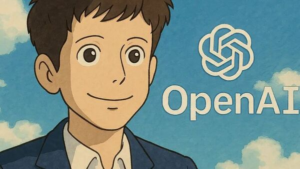In recent months, social media has been flooded with captivating images that seem to blur the line between reality and animation. At first glance, they resemble photographs — but look again, and you’ll see dreamlike scenes infused with soft lighting, painterly textures, and that unmistakable Studio Ghibli charm. Welcome to the era of Ghibli-style AI art.
🌟 A New Aesthetic, Powered by AI
Thanks to advanced image generation models like OpenAI’s “4o Image Generation”, users can now create high-resolution images based on simple text prompts. One of the most beloved emerging trends? Ghibli-inspired scenes reminiscent of Spirited Away or Howl’s Moving Castle.
From everyday creators to major corporations:


- Airbus posted a Ghibli-styled version of its BelugaXL cargo plane.
- Sam Altman, OpenAI’s CEO, updated his profile picture with a Ghibli-esque self-portrait.
Clearly, Ghibli is more than a cinematic style — it’s become a visual shorthand for warmth, whimsy, and emotional storytelling.
⚠️ The Ethical Elephant in the Room: AI Training Data
As stunning as these images are, a deeper issue lies beneath the surface — how these AI models learned to “create” in the first place.
AI art generators are typically trained on massive datasets scraped from the internet, which often include copyrighted artwork, illustrations, and styles — many of them created by human artists who never gave permission for their work to be used this way.
In the case of Ghibli-style art, this raises pressing ethical questions:
- Was Studio Ghibli’s visual language used in training datasets without consent?
- Can an AI model legally and ethically mimic a signature artistic style?
- Should creators be notified or compensated when their work becomes training material?
These aren’t abstract questions. In multiple ongoing lawsuits, artists allege that AI companies have essentially reverse-engineered their styles by feeding their art into generative models — without credit, compensation, or consent.
The practice may be legal under current “fair use” interpretations in some countries, but legality is not the same as ethics. When an artist’s life’s work becomes raw data, it challenges the very foundation of creative ownership.
🧠 “Style Theft” or Democratic Art?
Some argue that generative AI democratizes creativity, allowing anyone to make beautiful images — even if they can’t draw. But others argue it’s simply automated plagiarism, especially when the model replicates the feel of a specific artist or studio.
Consider this:
- If a human artist created a painting “in the style of Ghibli,” it would be called homage or fan art.
- If AI does the same using a model trained on thousands of such works, where is the line between homage and exploitation?
The fact that these models can replicate emotion without understanding it — something Hayao Miyazaki himself criticized as “an insult to life” — deepens the ethical complexity.
🏛️ Toward an Ethical Framework
The industry is slowly responding:
- Some AI companies now allow artists to “opt out” of training datasets.
- Others are exploring licensed training data — training only on works they’ve obtained rights to.
- Policy makers in the EU, US, and Japan are debating new laws to govern AI copyright and training practices.
But progress is slow, and the global nature of the internet means these issues don’t stop at national borders.
🧵 Beyond Art — A New Creative Economy?
This debate extends far beyond fan art. In fashion, for example, companies now generate entire lookbooks using AI models. Some brands even create and promote fully AI-generated influencers. The creative economy is evolving fast — but perhaps faster than our ethics and laws can keep up.
🚀 So, What Happens Now?
AI-generated art is not just about pixels and prompts — it’s about people. It’s about how we define originality, respect creative labor, and protect cultural heritage in the age of machines.
We must ask:
Can we build an AI-driven creative future that respects the past, empowers the present, and inspires the future — without erasing the people behind the magic?
